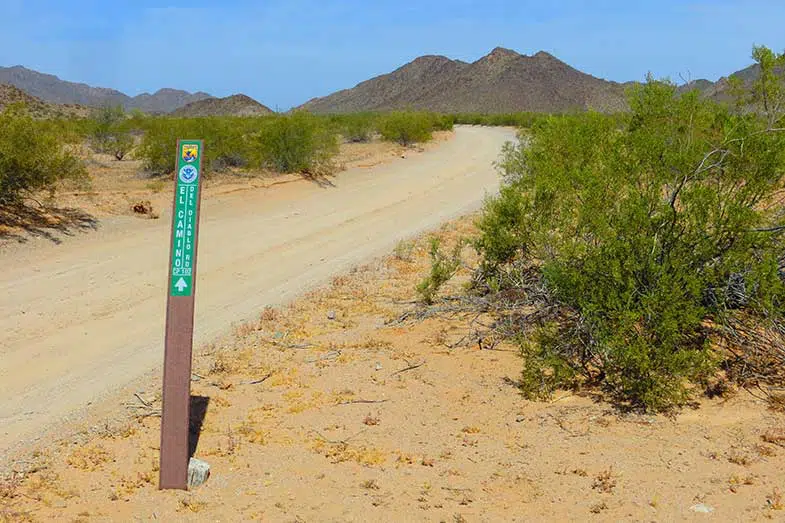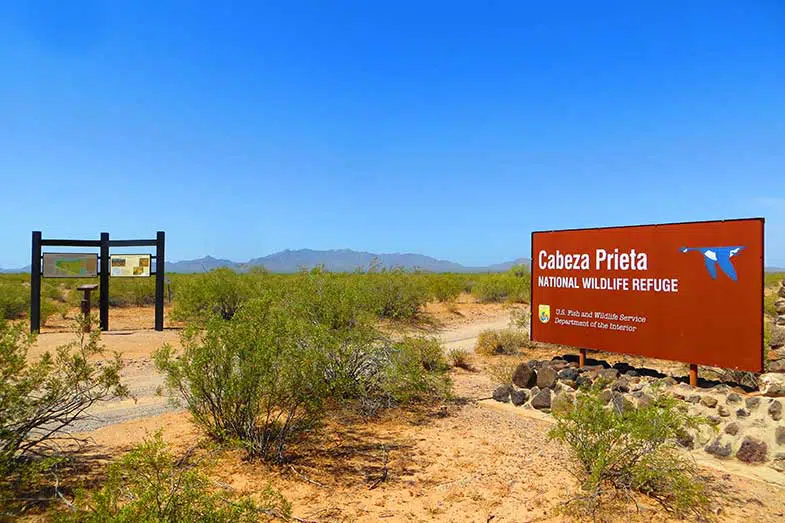El Camino Del Diablo, also known as “The Devil’s Highway,” has a morbid reputation. It earned its name from the difficulties that early explorers suffered while traveling through the trail. Not everyone who passed this route made it out alive. As of this writing, around 65 graves line the road.
Despite its not-so-pleasant reputation, it’s a popular trail for adventurous off-roaders. This iconic trail gives you the best view of the Sonoran Desert. If you’re looking for an exciting, adrenaline-pumping journey that promises spectacular sights, take on El Camino Del Diablo.
Now, let’s explore the history behind the Devil’s Highway.

El Camino Del Diablo History
El Camino del Diablo is believed to be at least 1,000 years old. It was originally a Native American foot trail and got its name from a Spanish expedition led by Captain Melchor Diaz in 1540.
Accompanied by native guides, Captain Melchor Díaz and his team used this trail to travel to California. The trail got its name from the many hardships that explorers suffered throughout the expedition. Jesuit priest Eusebio Francisco Kino, Jacob Sedelmayr, and Juan Bautista de Anza are among the early travelers who set foot on this trail.
Historians estimate that between 400 to 2,000 travelers have died on the El Camino Del Diablo, primarily due to extreme thirst, sunburn, and heatstroke. The last 30 miles of the trail to Yuma are lined with graves.
Horses arrived in the latter part of the 17th century. A hundred years later, oxcarts and wagons followed. A motor car crossed the route for the first time in 1915.

In the 1840s, Mexican migrants used the trail to go to California during the Gold Rush.
When the Southern Pacific Railroad reached Yuma in 1870, the trail suddenly became less frequent. It eventually stopped being a major migration route, but it was still occasionally used by surveyors and cartographers.
In 1978, El Camino del Diablo was listed on the National Register of Historic Places.
How Difficult is the El Camino Del Diablo Trail?
One of the things that could make El Camino Del Diablo hell on earth is the sweltering heat. Temperatures can shoot up to 120 °F (50 °C) in the summer. People have died of dehydration, sunburn, and heatstroke.
While temperatures are forbidding, El Camino Del Diablo is an easy trail. The road doesn’t require special skills to navigate and is well maintained. However, you do need a high-clearance, four-wheel-drive vehicle.
One of the obstacles you should watch out for is the “playa,” a dry lakebed at the Pinta Sands. A recent rain produces deep mud holes, which make them practically impassable. Also, watch out for washed out sections in the Tijinas Altas Pass.
The trail is easier to traverse during dry weather, but you would have to contend with the unbearable heat.
How Long Does the El Camino Del Diablo Take to Drive?
Although it’s possible to drive through the whole trail in a day, it’s not advisable. You might want to give yourself 2 to 4 days to complete the trip. It might be best to travel with someone who’s driving another vehicle. That way, you’ll have enough storage space for supplies, and you won’t be stuck in one place just in case your vehicle breaks down.
When is the Best Time to Travel the El Camino Del Diablo?
The best months to travel and take pictures are from October through April. Avoid traveling during the summer months because the weather conditions are harsher. Also, the heat will limit what you can do on the trail.
To give you an idea of what the trail looks like, here’s an El Camino Del Diablo map from Google:
How To Prepare for the Drive on El Camino Del Diablo?
Your safety should take top priority when you plan and prepare to go to El Camino Del Diablo. These tips will go a long way in ensuring that you’ll have a safe and pleasant trip:
- Get a permit and register for this trip. It’s a must.
- Find out the current road and travel conditions. You should be ready for unpredictable situations. Flash floods, windstorms, soft sand, extreme heat, and washouts are among the things that could take you by surprise and cause your vehicle to fail.
- Let your friends or family know that you’re going there, your plans, and when you will be back. If anything happens to you, your family or friends will surely call for help.
- Be well prepared and extremely careful. Little mishaps such as a spilled water container, a dead battery, etc., can lead to disastrous consequences. Double-check your gas gauge, brakes, and tires before you leave.
- Make sure that you have enough essentials: water, food, and fuel, and shelter. Be warned that there are no services in the area between Ajo and Yuma, so make sure you pack adequate supplies. Start traveling with a full tank. If possible, bring more water than necessary. An average adult needs two gallons of drinking water each day in warm weather. Do NOT rely on desert waterholes or “wildlife water.” Many people have lost their lives, thinking they could find water in those places.
El Camino Del Diablo: Sights to See
If you come to the Devil’s Highway well-prepared and are willing to brave the harsh conditions on the trail, you will get some spectacular views of land formations and pristine desert wilderness. You’ll also have the opportunity to visit some sites that allow you to immerse yourself in history.
Here are some of the sights that make the trip along the Devil’s Highway well worth the trouble:
Ajo, Arizona – Ajo is a community in Pima County, Arizona. Here, you’ll find the iconic plaza, majestic old churches, and the Curley School, a historic building that has been renovated into housing for artists. If you go east to the Pipeline Road, you’ll see the following mountains on the horizon: Pozo Redondo Mountains, Sikort Chuapo Mountains, and the Sauceda Mountains, including the famous Coffee Pot Mountain.
The Ajo Mountains – These feature high peaks and deep canyons formed from rhyolite, andesite lava flows, and tuffs 36 to 17 million years ago. The higher elevations support many “sky island” relic plants that were more widespread before the Sonoran Desert was formed about 10,000 years ago. They include red berry juniper, littleleaf mulberry, scrub oak, and Sonoran Desert rosewood.
Organ Pipe Cactus National Monument – This park is a UNESCO biosphere reserve and the only place in the country where the organ pipe cactus grows wild. El Camino Del Diablo traverses a section of the monument.
The Arizona Department of Transportation has classified twenty-two miles of Highway 85 through the park as a Scenic Roadway due to its visual, historical, and cultural significance. You can see much of the Sonoran Desert ecosystem from this section of the trail and rock formations and mountains.
The Bates Well Ranch – This was one of the 15 ranches in the Gray family cattle business, and now part of the Organ Pipe Cactus National Monument. The ranch exemplifies the Sonoran Desert’s frontier ranching pattern during the first three decades of the 20th century.
Black Mountain – Standing at 3,008 feet, the Black Mountain is an eroded remnant of a basaltic volcano. It has horizontal banding indicating differences in hardness between the basalt flows and softer tuffs. Its brown-black color with a hint of red is from oxidation and weathering.
Locomotive Rock – This is a fanglomerate rock-formation whose silhouette looks like an old railroad locomotive from certain angles.
Dave O’Neill’s Gravesite – Of all the makeshift graves that line the El Camino Del Diablo trail, this one is probably the most famous. It consists of a rusted iron cross and a pile of rocks. Visitors stop by this grave to pay their respects and leave tokens such as coins, bullets, and water bottles. O’Neill was a prospector who succumbed to exposure and dehydration during a storm on the trail. He was buried in 1915.
The Wildlife – The Sonoran Desert may be inhospitable to most humans, but it’s home to rare, beautiful animals. The Sonoran pronghorn is one of them, an endangered deer species that you might encounter in the desert. Only 200 of them live in the U.S. The animal looks like an antelope, but it belongs to a unique family (Antilocapridae).
You might see another group of charming animals in the desert called the “red velvet mite.” These harmless little critters appear as if by magic, making the sand come alive with a beautiful red hue.
But it would be wise just to let insects be. Like wingless wasps and tarantula wasps, some of them inflict searing pain when they sting and may cause allergic reactions. But they generally ignore people unless they’re bothered.
Safety on The Devil’s Highway
While the El Camino Del Diablo trail is easy to navigate, it’s not without its dangers. It always pays to be well-prepared and cautious. Here are some safety tips to keep in mind so that you can avoid life-threatening situations:
- Obey all signs, rules, and regulations. They are meant to protect you and keep you safe.
- If your vehicle breaks down or gets stuck, DO NOT leave your vehicle. Agents, rangers, and wardens patrol the area. Wait for them to find you. If you get stranded, don’t panic. Look for shade. Raise your vehicle’s hood. Use mirrors and beep your horn to get the attention of those who can help you.
- Drive carefully. El Camino Del Diablo is a highway with one lane, but the traffic goes two ways. The speed limit is 25 miles per hour. In some areas, there are rocks and broken branches that can puncture your tires. Also, watch out for chuckholes, mud holes, and soft sand. Keep in mind that there are many blind curves and hills on the trail. You may not see a vehicle speeding toward you, so be extra cautious when you drive.
- Avoid suspicious people. You might run into smugglers and illegal immigrants. Very few tourists have had trouble with them, but it still pays to be careful.
Cell phone service is unreliable or even non-existent in some areas of the trail. Also, medical help is miles away. So do your very best to stay out of trouble.
Are There Camping Sites Near El Camino Del Diablo?
There are many camping sites. For a fee, you can camp in Alamo Canyon or the Organ Pipe Cactus National Monument. There are also several dispersed campsites from 1.25 to about 5 miles from Ajo.

When you get to the Cabeza Prieta National Wildlife refuge, here’s where you can go camping:
- Papago Well Campground
- Tule Well Campground
- Christmas Pass primitive camping area (7 miles north of Tule Well)
A few of the best camping areas are in the Tinajas Altas Mountains. However, there are pioneer graves around the area, which isn’t much of a problem if you’re not easily spooked.
You can use the fire rings built around there for a campfire, but you’re going to need to bring your own firewood. Cutting of wood is not allowed.
Conclusion – El Camino Del Diablo
El Camino Del Diablo is a trail that’s rich in history and natural beauty. It’s easy to navigate; however, the harsh environment, especially the scorching temperature, can make it dangerous. But if you come well-prepared and take the necessary safety precautions for the trip, it can be a memorable and worthwhile off-road adventure.
Kris is an avid off-roader and outdoor enthusiast who loves to brave the elements and take on challenging terrain. He also enjoys sharing his passion and knowledge with others so that they, too, can appreciate the ride.
About Kris
